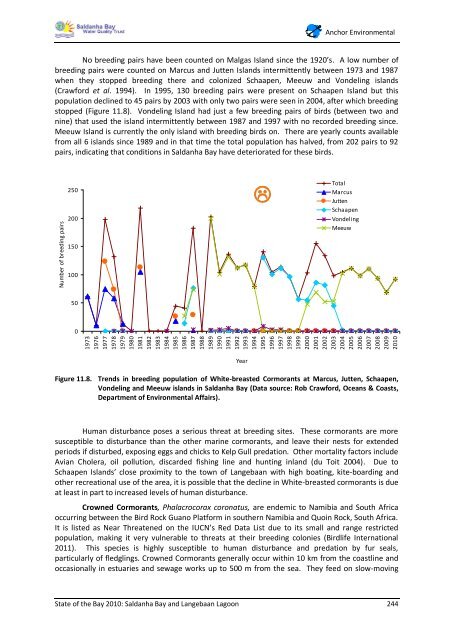State of the Bay Report 2010-Final - Anchor Environmental
State of the Bay Report 2010-Final - Anchor Environmental
State of the Bay Report 2010-Final - Anchor Environmental
You also want an ePaper? Increase the reach of your titles
YUMPU automatically turns print PDFs into web optimized ePapers that Google loves.
<strong>Anchor</strong> <strong>Environmental</strong><br />
No breeding pairs have been counted on Malgas Island since <strong>the</strong> 1920’s. A low number <strong>of</strong><br />
breeding pairs were counted on Marcus and Jutten Islands intermittently between 1973 and 1987<br />
when <strong>the</strong>y stopped breeding <strong>the</strong>re and colonized Schaapen, Meeuw and Vondeling islands<br />
(Crawford et al. 1994). In 1995, 130 breeding pairs were present on Schaapen Island but this<br />
population declined to 45 pairs by 2003 with only two pairs were seen in 2004, after which breeding<br />
stopped (Figure 11.8). Vondeling Island had just a few breeding pairs <strong>of</strong> birds (between two and<br />
nine) that used <strong>the</strong> island intermittently between 1987 and 1997 with no recorded breeding since.<br />
Meeuw Island is currently <strong>the</strong> only island with breeding birds on. There are yearly counts available<br />
from all 6 islands since 1989 and in that time <strong>the</strong> total population has halved, from 202 pairs to 92<br />
pairs, indicating that conditions in Saldanha <strong>Bay</strong> have deteriorated for <strong>the</strong>se birds.<br />
Number <strong>of</strong> breeding pairs<br />
250<br />
200<br />
150<br />
100<br />
50<br />
0<br />
1973<br />
1976<br />
1977<br />
1978<br />
1979<br />
1980<br />
1981<br />
1982<br />
1983<br />
1984<br />
1985<br />
1986<br />
1987<br />
1988<br />
1989<br />
1990<br />
1991<br />
1992<br />
1993<br />
1994<br />
1995<br />
1996<br />
1997<br />
1998<br />
1999<br />
2000<br />
2001<br />
2002<br />
2003<br />
2004<br />
2005<br />
2006<br />
2007<br />
2008<br />
2009<br />
<strong>2010</strong><br />
<strong>State</strong> <strong>of</strong> <strong>the</strong> <strong>Bay</strong> <strong>2010</strong>: Saldanha <strong>Bay</strong> and Langebaan Lagoon 244<br />
Year<br />
Total<br />
Marcus<br />
Jutten<br />
Schaapen<br />
Vondeling<br />
Meeuw<br />
Figure 11.8. Trends in breeding population <strong>of</strong> White-breasted Cormorants at Marcus, Jutten, Schaapen,<br />
Vondeling and Meeuw islands in Saldanha <strong>Bay</strong> (Data source: Rob Crawford, Oceans & Coasts,<br />
Department <strong>of</strong> <strong>Environmental</strong> Affairs).<br />
Human disturbance poses a serious threat at breeding sites. These cormorants are more<br />
susceptible to disturbance than <strong>the</strong> o<strong>the</strong>r marine cormorants, and leave <strong>the</strong>ir nests for extended<br />
periods if disturbed, exposing eggs and chicks to Kelp Gull predation. O<strong>the</strong>r mortality factors include<br />
Avian Cholera, oil pollution, discarded fishing line and hunting inland (du Toit 2004). Due to<br />
Schaapen Islands’ close proximity to <strong>the</strong> town <strong>of</strong> Langebaan with high boating, kite-boarding and<br />
o<strong>the</strong>r recreational use <strong>of</strong> <strong>the</strong> area, it is possible that <strong>the</strong> decline in White-breasted cormorants is due<br />
at least in part to increased levels <strong>of</strong> human disturbance.<br />
Crowned Cormorants, Phalacrocorax coronatus, are endemic to Namibia and South Africa<br />
occurring between <strong>the</strong> Bird Rock Guano Platform in sou<strong>the</strong>rn Namibia and Quoin Rock, South Africa.<br />
It is listed as Near Threatened on <strong>the</strong> IUCN’s Red Data List due to its small and range restricted<br />
population, making it very vulnerable to threats at <strong>the</strong>ir breeding colonies (Birdlife International<br />
2011). This species is highly susceptible to human disturbance and predation by fur seals,<br />
particularly <strong>of</strong> fledglings. Crowned Cormorants generally occur within 10 km from <strong>the</strong> coastline and<br />
occasionally in estuaries and sewage works up to 500 m from <strong>the</strong> sea. They feed on slow-moving

















